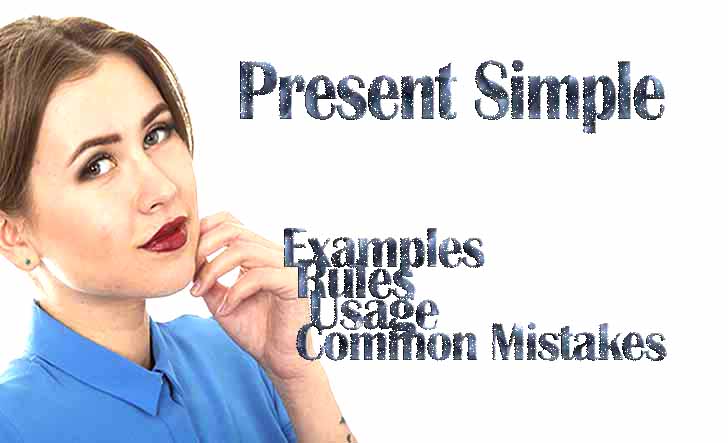Are you ready to conquer present indefinite tense examples rules usage common mistakes and truly elevate your English? Ever feel a bit stuck when talking about your daily routine, or trying to explain a simple fact in English? Do you ever wonder how to clearly communicate things that happen all the time, or truths that are always, well, true?
If so, you’re not alone! It’s a common hurdle for many English learners and even native speakers who want to refine their skills.
What is the Present Indefinite Tense (Simple Present)?

That’s where the Present Indefinite Tense comes in, also widely known as the Simple Present Tense or just the Present Simple. It’s absolutely fundamental for smooth, natural English chat and everyday communication.
-
Importance in English communication (daily habits, facts, universal truths)
In this ultimate guide, We’ll explore the essential rules, uncover tons of practical usage examples, rules, usage, and common mistakes, that everybody makes – and show you exactly how to avoid them.
This isn’t just theory; it’s your go-to resource for a solid understanding of the basic present tense. Whether English is your first language, or you’re an ESL student looking to truly boost your English Present Tense understanding and fluency, this guide is designed specifically for you.
So, What Exactly IS the Present Indefinite Tense?
Here’s a common misunderstanding right off the bat: many people think “present tense” always means something is happening right this very second. But hold on! it’s a subtle but crucial difference, and understanding it is key to using this fundamental tense correctly.
Expressing actions that are habitual, regular, factual, or generally true.
So, what is it then? At its heart, the Present Indefinite Tense is our go-to for actions that are regular, habitual, or generally true. It describes actions that happen repeatedly, things that are always facts, or even events that are part of a fixed schedule. For example,
-
- “The sun rises in the east” is a universal truth. The sun isn’t rising only at this precise moment; it happens every day.
- “I drink coffee every morning.” This isn’t about me sipping coffee right now; it’s my daily habit.
How it differs from other present tenses?
You might also hear this called the Simple Present Tense or just the Present Simple. Its core function is to express these constant realities and routines.
It’s distinct from other present tenses, like the Present Continuous. The Present Continuous (e.g., “I am drinking coffee”) tells you something is happening at this very instant.
Building Blocks: Mastering Present Indefinite Tense Examples Rules
Now, let’s tackle the “how.” Many people fret about the rules for building these sentences, especially that tricky ‘s’ at the end of some verbs. But here’s the truth: forming the Simple Present Tense is actually super straightforward once you grasp a couple of key ideas.
It’s not about memorizing endless exceptions; it’s about understanding a few logical patterns. We’re about to make verb conjugation in this tense a breeze, setting you up for true English fluency.
The Super Easy Part (Most Verbs!):
Good news first! For most subjects – “I,” “you,” “we,” and “they” – the verb stays exactly as it is in its base form. No changes, no fuss! This makes a huge chunk of Present Simple sentences incredibly simple to construct.
- I walk to work every day.
- You eat breakfast with me.
- We play soccer on Sundays.
- They read books in the evening.
See? Easy peasy! This is a core part of the detailed guide to present indefinite tense formation.
The “S” Factor (for “he,” “she,” “it”) – Don’t Miss This!
Now, here’s the one part that often trips people up: the third-person singular. That’s “he,” “she,” or “it.” When these guys are your subject, the verb usually gets an extra “-s” or “-es.” It’s a tiny change that makes a big difference and is crucial for understanding subject-verb agreement in present simple.
- He walks to school.
- She eats an apple.
- It rains a lot here.
Ready for the specific tricks for adding that “-s” or “-es”?
Quick Tricks for Adding “-s” or “-es” (The Nitty-Gritty Details!)
It’s all about the last letter of the verb! This will help you get those English verb forms just right.
-
Add “-es” if the verb ends in -s, -ss, -sh, -ch, -x, or -o:
- wash washes (She washes her car.)
- pass passes (He passes the ball.)
- watch watches (She watches TV.)
- go goes (He goes to the gym.)
- fix fixes (It fixes itself.)
-
Change “y” to “i” and add “-es” if the verb ends in a consonant + y:
- study studies (He studies hard.)
- try tries (She always tries her best.)
-
Just add “-s” if the verb ends in a vowel + y (or any other letter!):
- play plays (She plays the piano.)
- run runs (He runs fast.)
- sing sings (It sings beautifully.)
This specific guidance on endings is a vital part of present indefinite tense rules with examples for beginners.
Saying “No” (Negative Sentences) – It’s Easier Than You Think!
Want to tell someone you don’t do something? We bring in a helper word: “do” or “does” (our auxiliary verbs do does), followed by “not,” and then the original base form of the main verb. This is exactly how to make negative sentences with present indefinite.
- Structure: Subject + do/does + not + base form of verb.
- I do not play video games. (Or, shorter: I don’t play video games.)
- She does not sing in the shower. (Or, shorter: She doesn’t sing in the shower.)
Asking Questions (Interrogative Sentences) – Get Curious!
Time to get curious! To ask a question in the Present Indefinite Tense, you just move “Do” or “Does” to the very beginning of the sentence. Then comes your subject, and finally, the base form of your main verb.
- Structure: Do/Does + Subject + base form of verb?
- Do you work here?
- Does he read books often?
- Do they speak Spanish?
We can also ask “Wh-questions” (like what, when, where, why, how). Just put the “Wh-word” at the very front!
- When do you wake up?
- Where does she live?
- Why do they laugh?
The “To Be” Special: (am, is, are) – A Little Rebel with Its Own Rules!
Alright, the verb “to be” is a bit of a rebel. It doesn’t use “do” or “does” to form negatives or questions in the English Present Tense. Instead, it changes its own form based on the subject:
-
Formation:
- I am
- He/She/It is
- You/We/They are
-
Usage:
We use “to be” to talk about states of being, identity, or characteristics.
-
- I am a student.
- She is happy.
- They are friends.
-
Negative “To Be”:
Just add “not” right after “am,” “is,” or “are.”
-
- I am not tired.
- He is not here.
- They are not coming.
-
Interrogative “To Be”:
Just swap the “to be” verb and the subject.
-
- Am I late?
- Is he busy?
- Are they ready?
When to Use the Present Indefinite Tense
Many learners think it’s only useful for describing basic, almost boring, daily routines. Like,
-
- I brush my teeth.
It pops up everywhere from scientific facts to movie schedules, and even in live sports commentary. Get ready to truly understand its range and boost your English Present Tense skills!
1. Your Daily Routine & Habits – Your Go-To for Everyday Life!
This is the classic, bread-and-butter use of the Present Indefinite Tense. We use it to talk about actions that you do regularly, things that are part of your routine, or habits that happen again and again. These aren’t one-time events; they’re recurring!
- I drink coffee every morning.
- She goes to school five days a week.
- My dog barks when the mailman arrives.
- They always visit their grandparents on Sundays.
Notice those helpful little words like always, often, usually, sometimes, never, every day/week/year, or on Mondays? These adverbs of frequency are best friends with the Present Simple, signaling that an action is habitual.
Hey, what do you usually do on weekends?
Well, I wake up late, then I go for a run, and in the evening, I often read a book.
2. Facts That Never Change (General Truths) – The Immutable Truths!
The Present Indefinite Tense is perfect for stating facts that are universally accepted, scientific truths, or general statements that are always true. It doesn’t matter when you say them; they remain factual. These are solid general truths sentences crucial for describing facts English.
- The sun rises in the east.
- Water boils at 100 degrees Celsius.
- Birds fly.
- The Earth revolves around the sun.
3. Future Events on a Schedule – Planning Ahead, Present Style!
Here’s where the Present Indefinite gets interesting! Even though it’s a “present” tense, we frequently use it to talk about future events that are part of a fixed schedule, timetable, or program. Think about public transport, school classes, or movie screenings.
- The train leaves at 7 PM tonight.
- The concert starts at 8 o’clock.
- My flight departs at noon tomorrow.
- The semester ends on December 15th.
Comparative Analysis: You might wonder, How’s this different from
- The movie will start at 8 PM?
The key is fixed schedule. If it’s on a timetable that won’t change, the Present Indefinite is often preferred.
“Will start” emphasizes a future action, while “starts” implies it’s a pre-determined, set event.
4. Feelings, Thoughts & Possession (Stative Verbs) – Expressing Your Inner World!
Some verbs describe states, feelings, opinions, or possession, rather than active actions. These are called stative verbs, and they typically use the Present Indefinite Tense, even if the state is ongoing right now.
They usually don’t use the ‘-ing’ form (Present Continuous) in these contexts. We’ll explore various stative verbs examples and why they behave this way.
- Verbs of perception: see, hear, smell, taste, feel
- I hear music. (Not “I am hearing music.”)
- Verbs of emotion: love, hate, want, like, prefer
- She loves chocolate. (Not “She is loving chocolate.”)
- Verbs of possession: have, own, belong
- He has a new car. (Not “He is having a new car” for possession.)
- Verbs of thought/opinion: think, believe, know, understand, remember
- I believe in magic.
- She knows the answer.
5. Sports Commentary & Storytelling – Making Moments Come Alive!
Commentators in sports or narrators describing live events often use the Present Indefinite Tense to make the action feel immediate and exciting, as if it’s unfolding right before your eyes.
This is also known as the historical present tense when used for dramatic effect in narratives about the past.
- The striker shoots, and he scores!
- The actor enters the stage and begins his monologue.
- Newspapers frequently use this for impactful headlines, making old news sound current: “President Arrives for Summit” (even if it happened yesterday). Authors also use it to add immediacy to their stories: “She opens the old book, and suddenly, a strange light fills the room.”
6. Giving Instructions & Directions – Your Step-by-Step Guide!
When you’re giving commands, instructions, or directions, the Present Indefinite Tense is your best friend. It’s clear, concise, and direct, making it easy for the listener to follow. This is also related to imperative sentences.
- You open the box, then you mix the ingredients thoroughly.
- First, you turn right at the corner, then you walk two blocks straight.
- To make this recipe, you add two cups of flour, then you stir well.
7. Asking All Kinds of Questions (Wh-questions) – Getting the Answers You Need!
We touched on this in formation, but it’s crucial for usage. When you want specific information about habits, facts, or schedules, combine a “Wh-word” (who, what, when, where, why, how) with “do/does” and the base verb. This shows you precisely how to use present indefinite tense correctly for various queries.
- When do you usually eat dinner?
- Where does he live?
- Why do they laugh so much?
- How does she manage her time?
8. Conditional Sentences (Type 0 and Type 1 – in the ‘if’ clause) – Cause and Effect!
The Present Indefinite Tense plays a key role in certain types of conditional sentences, which talk about cause and effect.
-
Type 0 Conditional (for general truths or scientific facts):
- If you heat ice, it melts. (Always true!)
- If it rains, the ground gets wet.
-
Type 1 Conditional (for real possibilities in the future):
The Present Indefinite appears in the “if” clause, and the main clause uses “will” + base verb.
-
- If you study hard, you will pass the exam.
- If she comes late, we will miss the beginning.
See how versatile the Present Indefinite Tense truly is? It’s far more than just “I walk.” By understanding these diverse uses, you’re building a super strong foundation for your English language proficiency.
-
Habitual Actions / Daily Routines:
- Examples: I drink coffee every morning. She goes to school five days a week.
- Keywords: always, often, usually, sometimes, never, every day/week/year, on Mondays, etc.
-
General Truths / Facts / Universal Statements:
- Examples: The sun rises in the east. Water boils at 100 degrees Celsius.
-
Scheduled Events / Timetables (Future Context):
- Examples: The train leaves at 7 PM. The concert starts at 8 o’clock.
-
States / Feelings / Opinions (Stative Verbs):
- Verbs of perception (see, hear, smell, taste), emotion (love, hate, want), possession (have, own), thought (think, believe, know).
- Examples: I love pizza. She knows the answer. He believes in magic.
-
Commentaries/ Narrations (Live Events, Sports):
- Examples: The striker shoots, and he scores! The actor enters the stage.
-
Instructions / Directions:
- Examples: You open the box, then you mix the ingredients.
-
Conditional Sentences (Type 0 and Type 1 – in the ‘if’ clause):
- Type 0: If it rains, the ground gets wet.
- Type 1: If you study hard, you will pass the exam.
Common Mistakes to Avoid (And How to Fix Them)

So, you’ve got the basics of the Present Indefinite Tense down, and you’re starting to see just how versatile it is. Awesome! But here’s a little secret: even experienced English speakers sometimes trip up on a few common points. The biggest misconception? Thinking that just knowing the rules means you won’t make mistakes. Nope!
The real mastery, the kind that makes your English sound truly natural, comes from understanding why these slip-ups happen and having simple, actionable ways to fix them. Let’s tackle these head-on, so you can avoid those common errors in present indefinite tense sentences!
1. Mistake: The Missing “S” or “ES” – The Sneaky Culprit!
It’s crazy how often this little “s” or “es” gets forgotten when talking about “he,” “she,” or “it.” People often remember to add ‘s’ for plural nouns (e.g., “three cats“), but then forget it for singular verbs describing singular subjects (e.g., “he walks“). It’s a classic mix-up!
- Mistake Example: He walk to school.
- Correction: He walks to school.
Actionable Tip: The ‘S’ Rule Checklist!
- Why it happens: This often comes from how our native languages work, or simply rushing. We forget that in English, if your subject is singular (like “he,” “she,” “it,” “the dog,” “Sarah“), the verb needs that little “s” or “es” buddy! It’s all about subject-verb agreement in present simple.
- How to fix: Before you say or write a sentence in the Present Indefinite Tense, do a quick mental check:
- Who is doing the action?
- Is it he, she, it (or a single person/thing)?
- If YES, does my verb have an -s or -es? (Remember those rules for endings like -ch, -sh, -o!)
2. Mistake: Mixing Up “Do” and “Does” – The Auxiliary Annoyance!
Another common grammar headache? Knowing whether to use “do” or “does” when you’re making a negative statement or asking a question. People sometimes just slap “not” after the main verb (like “She not like coffee”) or skip the helper word (“Like you pizza?”).
- Mistake Example: She not like coffee.
- Correction: She does not like coffee.
- Mistake Example: Like you pizza?
- Correction: Do you like pizza?
Actionable Tip: Your Auxiliary Buddy System!
- Why it happens: Many languages don’t use auxiliary (helper) verbs in the same way, so it feels unnatural at first.
- How to fix: Remember this simple pairing for how to make negative sentences with present indefinite and how to make interrogative sentences with present indefinite:
- Use DO (or don’t) with: I, you, we, they (and plural nouns).
- Use DOES (or doesn’t) with: he, she, it (and singular nouns).
- Think of it this way: “does” already has the “s” sound, so it goes with the same subjects that get the “s” on the main verb! And remember, once you use “do” or “does,” the main verb goes back to its base form – no extra “s” needed!
3. Mistake: “Happening Now” vs. “Always Happening” – The Big Confusion!
This is perhaps the biggest culprit leading to common English grammar errors with the Present Indefinite Tense. Many learners confuse it with the Present Continuous because both talk about “now” in some way. But they’re fundamentally different!
- Mistake Example: I am usually walking to work. (If it’s a habit)
- Correction: I usually walk to work.
Actionable Tip: The ‘Now’ vs. ‘Always’ Test!
- Why it happens: Both tenses relate to “present,” but one is about this very moment (continuous) and the other is about general truths or habits.
- How to fix: Ask yourself: Is this action happening right this second? (Use Present Continuous: “I am walking to work now.”) Or is it something that happens regularly, generally, or always? (Use Present Indefinite Tense: “I walk to work every day.”) This simple test is key to knowing when to use simple present tense vs present continuous. We can also briefly compare it with how “used to” or “would” describes past habits, ensuring you pick the right tense for the right time.
4. Mistake: Where Do Those Adverbs Go? – The Right Place for “Always” & “Never”!
Adverbs of frequency (like always, often, usually, sometimes, never) are super helpful with the Present Indefinite Tense, but their placement can be tricky. Some learners put them at the very end or beginning of a sentence, or even right after the subject when it should be elsewhere.
- Mistake Example: Walks he usually to school.
- Correction: He usually walks to school.
Actionable Tip: Adverb Placement Power Play!
- Why it happens: Adverb placement in English can be flexible, but these specific adverbs have relatively fixed positions.
- How to fix: Remember these two golden rules for adverbs of frequency:
- Before the main verb: “She always reads before bed.”
- After the verb “to be”: “He is often late.”
5. Mistake: Sticking with Stative Verbs – They Don’t Like “-ING” Here!
This is a subtle but important point that often appears in discussions about Present Indefinite Tense Examples, Rules, Usage, and Common Mistakes. Many verbs describe actions, but others describe states or conditions rather than actions. These are stative verbs, and they generally don’t take the ‘-ing’ form in the present.
- Mistake Example: I am knowing the answer.
- Correction: I know the answer.
Actionable Tip: Stative Verb Spotlight: No -ING for States!
- Why it happens: We often over-apply the “action happening now = -ing” rule, forgetting that some verbs describe what is rather than what is being done.
- How to fix: Be mindful of verbs that express:
- Thoughts/Opinions: know, believe, understand, think (meaning “believe”)
- Feelings: love, hate, like, want, prefer
- Possession: have, own, possess, belong
- Senses (non-action): hear, see, smell, taste, feel These verbs are usually happy sticking to their Present Indefinite form. If you’re using “I am knowing,” you’re likely making a mistake – try “I know” instead!
Practice Exercises (Interactive / Self-Assessment)
Alright, you’ve read through the rules, soaked up the examples, and even identified those sneaky common mistakes. Think of it like learning to ride a bike – you can read all the manuals, but you only truly learn by pedaling!
1. Fill in the Blanks – Your Turn to Shine!
Read each sentence carefully and fill in the blank with the correct form of the verb given in brackets. Remember those rules for ‘s’ and ‘es’!
- My brother (study) ________ English every evening.
- We (go) ________ to the park on weekends.
- The Earth (revolve) ________ around the sun.
- She (not / like) ____________ spicy food.
- (Do / he / work) _______________ at the hospital?
- I (be) ________ very happy today.
- They (usually / eat) ____________ dinner at 7 PM.
2. True or False – Test Your Understanding!
Decide if each statement about the Present Indefinite Tense is True or False. This checks your understanding of the usage scenarios we discussed.
- The sentence “He is watching TV right now” uses the Present Indefinite Tense. (True/False)
- “Water freezes at 0 degrees Celsius” is a general truth expressed in the Present Indefinite Tense. (True/False)
- We use the Present Indefinite Tense to talk about fixed future events, like “The bus arrives at 9 AM.” (True/False)
- Verbs like “love,” “know,” and “believe” (stative verbs) commonly use the ‘-ing’ form in the present. (True/False)
- In the sentence “She never eats meat,” “never” is an adverb of frequency. (True/False)
3. Sentence Transformation – Reshape Your Sentences!
For each positive sentence below, transform it into both a negative sentence and an interrogative (question) sentence in the Present Indefinite Tense.
- They play tennis every Saturday.
- Negative:
- Question:
- Sarah reads detective novels.
- Negative:
- Question:
- The store opens at 9 AM.
- Negative:
- Question:
4. Spot the Mistake – Become a Grammar Detective!
Each sentence below has one common mistake related to the Present Indefinite Tense. Can you find it and correct it? This is great for fixing common errors in present indefinite tense sentences!
- He usually play video games after work.
- She not like pizza.
- Do he drives to work?
- I am understanding what you mean.
- My friend often is late for meetings.
5. Actionable Tip: Sentence Builder Challenge: From Passive to Power-User!
Beyond just correcting sentences, the best way to improve is by creating your own. This builds your active vocabulary and grammar skills.
- Your Daily Life: Write three sentences describing things you do every single day using the Present Indefinite Tense. (Example: “I drink a glass of water every morning.”)
- Universal Truths: Write two sentences stating a general truth or fact about the world around you. (Example: “Bees make honey.”)
- Tell a Friend’s Hobby: Imagine describing a friend’s regular hobby. Write a mini-dialogue (2-3 lines) using the Present Simple. (Example: “My sister plays guitar. She practices every day.”)
6. Actionable Tip: Make It Stick with Interactive Quizzes!
While these written exercises are awesome, don’t stop here! To truly master the Present Indefinite Tense Examples, Rules, Usage, and Common Mistakes, you should also:
- Find online interactive quizzes: Websites often have quick, self-correcting grammar quizzes present tense that give you instant feedback. This taps into effective learning methods, reinforcing concepts through immediate results.
- Use flashcards: Write a subject and a verb, then try to quickly say or write the correct Present Simple form.
- Practice speaking: Try to consciously use the Present Indefinite Tense when describing your day or general facts in conversation.
Advanced Tips & Nuances (For Mastery)

Okay, so you’re crushing the core Present Indefinite Tense Examples, Rules, Usage, and Common Mistakes! You know your ‘s’ from your ‘es’, you’re a whiz with ‘do’ and ‘does’, and you can tell a habit from an action happening right now. Fantastic! But here’s where we move beyond just being correct to truly sounding natural and impressive.
The biggest misconception at this level? Thinking grammar is always black and white. It’s not! Sometimes, the Simple Present Tense pops up in unexpected places, adding subtle but powerful meaning.
1. “When” and “While” Clauses: Timing Those Habitual Actions
You’re probably used to using “when” and “while” with tenses like the Past Continuous (“I was studying when he called”). But did you know the Present Indefinite Tense frequently appears with these words when we’re talking about habitual, repeated actions or general truths? It’s a key aspect of how clauses work in English grammar.
- When for habitual actions: We use “when” to show that one action regularly happens at the same time as another. It implies a routine cause-and-effect or simultaneity.
- When it rains, I always carry an umbrella. (This is a regular occurrence, not a single instance.)
- People get hungry when they exercise a lot. (A general truth.)
- While for simultaneous habitual actions: “While” can also describe two long actions happening at the same time, habitually.
- While she works, she often listens to music. (She does both regularly.)
2. Headlines / Newspaper Articles: The Power of the Present Simple!
Ever notice how newspaper headlines sound super dramatic and immediate? It’s often because they use the Present Indefinite Tense even when talking about events that happened in the past! This is a fascinating use known as the historical present tense, and it’s a staple of journalistic style.
- Why it happens: News outlets do this to make the information feel fresh, urgent, and like it’s happening right now. It grabs your attention and pulls you into the story immediately. It’s also incredibly efficient, saving space (which is precious in headlines!).
- Examples:
- “PRESIDENT ARRIVES FOR SUMMIT” (The arrival happened in the past, but the headline makes it feel immediate.)
- “TEAM WINS CHAMPIONSHIP” (The victory occurred, but the simple present adds impact.)
- “STORM HITS COASTLINE” (The storm hit, but the tense conveys ongoing impact/recency.)
3. Storytelling (Historical Present): Making Moments Come Alive!
Beyond headlines, writers and speakers sometimes use the Present Indefinite Tense in storytelling, even when recounting past events. This is another form of the historical present tense, and its purpose is purely for dramatic effect, to draw the listener or reader directly into the moment.
- Why it happens: When a storyteller switches from the past tense (“He walked down the street…”) to the Present Indefinite (“…and suddenly, a large dog jumps out!”), it creates a sudden jolt, as if you’re experiencing the event alongside the narrator. It makes the story more vivid and engaging.
- Examples:
- “So, I’m walking down the street yesterday, minding my own business, when suddenly this huge car screeches to a halt right in front of me! The driver gets out and starts yelling…”
- In novels: “She opens the old book, and a forgotten letter falls out. Her heart beats faster as she reads the faded words.” (Even if the entire story is set in the past, this switch creates immediacy.)
4. Phrasal Verbs: How They Integrate with the Present Simple
Phrasal verbs are those fantastic (and sometimes tricky!) combinations of a verb and a preposition or adverb (like “get up,” “turn off,” “look for”). They’re super common in everyday English, and they integrate seamlessly into the Present Indefinite Tense rules you’ve learned.
- Why it matters: Just like regular verbs, phrasal verbs follow the same rules for subject-verb agreement and forming negatives/questions in the Present Simple. Understanding this helps you use them naturally.
- Examples:
- Habitual Actions:
- I get up at 6 AM every day. (Not “I am getting up…”)
- She looks after her younger brother after school. (She regularly cares for him.)
- They turn off the lights when they leave a room. (It’s their habit.)
- Third-Person Singular: Remember that ‘s’ or ‘es’ on the verb part of the phrasal verb!
- He always shows up late for meetings.
- The alarm clock goes off at 5 AM.
- My car often breaks down in the winter.
- Habitual Actions:
The Foundation of English Grammar

Wow, you’ve journeyed through the entire landscape of the Present Indefinite Tense, and you should feel incredibly proud! If you’ve absorbed the insights, tackled the exercises, and thought about the nuances, you’re no longer just learning rules; you’re truly beginning to master one of the most vital building blocks of the English language.
Let’s do a quick recap of what you’ve conquered:
-
Formation
You’ve nailed the straightforward structure for “I, you, we, they” and, crucially, understood the “S” factor for “he, she, it.” You also know how to build negative sentences and questions using “do/does,” and how “to be” dances to its own beat.
-
Core Usages
You now recognize that this tense is your go-to for daily routines, unshakeable general truths, those fixed scheduled events, unchanging stative verbs, and even dynamic newspaper headlines and compelling storytelling.
-
Common Pitfalls
Most importantly, you’ve learned to spot and fix those sneaky mistakes related to the missing “s,” the “do/does” mix-up, confusing it with the Present Continuous, adverb placement, and handling stative verbs correctly.
What’s Next? Keep Growing Your English Skills!
This guide wasn’t just about rules; it was about empowering you to speak and write with a newfound fluency. If you believe this comprehensive, no-fluff guide can light up their learning path too, why not share it? A simple share helps fellow language adventurers unlock their potential, just like you have.
Got a tricky sentence you finally understand? Drop a comment below – your insights might just spark another breakthrough for someone else on their language journey. Let’s build a community of confident English speakers together! Your ongoing engagement fuels our mission to bring you more unbeatable content designed for real results.





